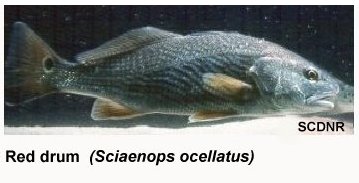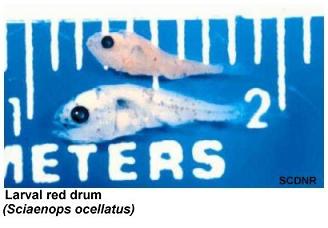Inshore Fisheries Research Section
Red Drum - Life History
Description
 The red drum is an important resource to local anglers. This fish is a member of the drum family, Sciaenidae. Locally, red drum are referred to as “spottail bass”, “redfish”, or “channel bass”. It is a close relative of the black drum, spotted seatrout, Atlantic croaker, and spot. Red drum have elongate bodies, are reddish-bronze in color, and have a distinct spot or series of spots at the base of the caudal fin. Scientists believe this prominent spot on the tail confuses predators into attacking the fish’s tail instead of its head, giving the fish a better chance to escape.
The red drum is an important resource to local anglers. This fish is a member of the drum family, Sciaenidae. Locally, red drum are referred to as “spottail bass”, “redfish”, or “channel bass”. It is a close relative of the black drum, spotted seatrout, Atlantic croaker, and spot. Red drum have elongate bodies, are reddish-bronze in color, and have a distinct spot or series of spots at the base of the caudal fin. Scientists believe this prominent spot on the tail confuses predators into attacking the fish’s tail instead of its head, giving the fish a better chance to escape.
Similar to other members of the drum family, the red drum has an inferior mouth and a lateral line that extends to the tip of the caudal fin. Male red drum produce ‘drumming’ sounds during the spawning season to attract females, as well as undergo a color change during this time. Spawning males change from their typical reddish-bronze to dark red or bluish gray on top with a pale underside.
Habitat
Along the Atlantic coast of the United States, red drum are found from Delaware to southern Florida. They also inhabit the Gulf of Mexico, from southern Florida to northeastern Mexico. In South Carolina, red drum can be found in estuarine and nearshore areas.
Red drum found inside South Carolina estuaries are typically juvenile fish; meaning they have not yet reached sexual maturity. These fish are often called sub-adults. Male red drum mature at age three (27-30 inches long), females mature at age four (32-36 inches).
As red drum develop, they utilize different habitats. Juvenile red drum are abundant in the shallow creeks that meander through cordgrass (Spartina alterniflora) marshes. As juveniles mature, their habitat preferences change. Sub-adult red drum can usually be found in larger creeks and rivers, although they have been observed in waters off barrier islands and sandbars.
Young red drum, between the ages of one and three, show a pattern of movement and feeding that is related to the tide. During the warm months, as the incoming tide begins to reach the marshgrass, fish move into the grass. Here, they feed on fiddler crabs (80% of their diet), mud crabs, grass shrimp, and fishes that are associated with this structured habitat. As the tide ebbs, the young red drum move off the marsh surface to the shallow water of tidal mudflats adjacent to the marsh. Most red drum prefer mud flats with structure, such as oyster reefs. This pattern of movement reduces their exposure to bottlenose dolphin, which is a major predator.
In winter, when water temperatures are low and the fiddler crabs are no longer active, red drum display the same pattern of tidal movement, but they become sluggish and less active since they are unable to regulate their body temperature, and therefore are more prone to predation by the bottlenose dolphin.
Adults are found in nearshore and coastal waters. As water temperatures decline in the fall (late October to November), adult red drum move gradually offshore to deeper, warmer water. This offshore movement initiates a flurry of successful surf fishing. Fish move back to nearshore waters with temperature increases in the spring. As inshore water temperatures warm, red drum move from deeper offshore waters to again inhabit the inlets and front beaches.
Spawning and Growth
Because of the difficulty in sampling the adult red drum stock, very little is known of their biology. Adult red drum in South Carolina spawn in August and September. Spawning activity is believed to be sparked with the cooling water temperatures and shorter days in August. Spawning in South Carolina is thought to occur in coastal inlets, including St. Helena Sound, although some nearshore spawning activity is believed to take place as well. Male red drum produce characteristic ‘drumming’ sounds by contracting muscles attached to the swim bladder, in an effort to attract females to spawning sites.
Fertilized eggs float in the water column, and hatching occurs in 28-29 hours, depending on water temperature.  Eggs hatch more quickly in warmer waters, and more slowly as water temperature declines. Upon hatching, larval red drum face the difficult task of reaching nursery grounds inside the estuary. Using currents generated by winds and tides, larvae make their way to shallow tidal creeks. By swimming towards the surface when currents are rising (flood tide), and staying close to the bottom when the tide is ebbing, these larvae eventually reach their destination. Once they reach the shallow water of estuarine creeks, the larvae settle out of the plankton community.
Eggs hatch more quickly in warmer waters, and more slowly as water temperature declines. Upon hatching, larval red drum face the difficult task of reaching nursery grounds inside the estuary. Using currents generated by winds and tides, larvae make their way to shallow tidal creeks. By swimming towards the surface when currents are rising (flood tide), and staying close to the bottom when the tide is ebbing, these larvae eventually reach their destination. Once they reach the shallow water of estuarine creeks, the larvae settle out of the plankton community.
Larval red drum feed on crustaceans and small fishes. The smallest feed on copepods, and as they grow, they eat ghost shrimp known as mysids, and eventually consume grass shrimp and panaeid shrimps.
As waters cool in December, these small fishes (1-3 inches long) leave the shallow marsh creeks for the relative warmth of deeper creeks and estuarine rivers. When temperatures rise in the spring, small red drum re-enter these tidal marsh creeks and begin to grow rapidly. At this time they feed on small fishes and crustaceans.
In May and June, these 8-10 inch fish begin to leave the small creeks to inhabit the open estuarine shallows. At one year of age (in September), red drum are10-12 inches long, and weigh just under one pound. Most meet the legal size of 15 inches by November (14 months of age) and weigh an average of 1.3 pounds. By December, many of these fishes may weigh almost two pounds.
This project was funded by a grant from the Cooperative Research Program of the National Marine Fisheries Service Southeast Regional Office.
